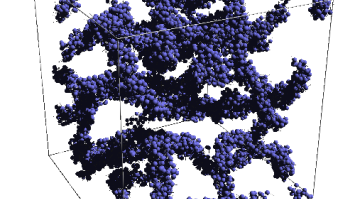
Press release -
Successful Use of AI Technology for Efficient Prediction of Physical Properties of Substances with Complex Molecular Structures
[Overview]
In the field comprised by a fusion of material and information sciences - a field being closely watched in recent years both in Japan and globally - although there are a tremendous amount of applications of functional materials such as surfactants, which are widely used in everyday products such as detergents, cosmetics and cement, an enormous number of calculations are required to manipulate such materials, and their complex molecular structures have been preventing the implementation of machine learning. This study combines molecular simulation with machine learning to demonstrate for the first time in the world, that it is possible to apply machine learning to predict physical properties of a representative type of functional materials, namely those functional materials that are derived by self-assembled molecules. This makes it possible to develop materials in an efficient manner, defying conventional wisdoms of material development.

<Distribution destinations of this material> Osaka Science and University Press Club (Osaka Kagaku Daigaku Kishakurabu), Education, Culture, Sports, Science and Technology Press Club (Monbukagaku Kishakai), Science Press Club (Kagaku Kishakai) and Higashiosaka City Government Press Club (Higashiosaka Shisei Kishakurabu).
[Featured Journal]
| Journal name: | “Nanoscale” (Impact factor: 7.233 2018)* An academic journal covering all areas of nanoscience and nanotechnology, with an international presence. |
| Name of academic paper: | Multiscale prediction of functional self-assembled materials using machine learning: High-performance surfactant molecules.(Prediction of multi-scale physical properties for self-assembled functional materials by using machine learning) |
| Authors: | Takuya Iguchi (expected to graduate from Master’s degree program at the Graduate School of Science and Engineering Research in 2019), Yoshinori Arai (Associate Professor of Mechanical Engineering Department at the Faculty of Science and Engineering of Kindai University), Li Na (Toyota Motor Corporation), Akira Moroboshi (Toyota Motor Corporation) |
[Background and Details]
Functional materials can be used to derive a variety of substances by altering their molecular structures - this molecular design is extremely important for product development. Since there is no established method for molecular design used in product development, trial-and-error experiments are used to derive desired functions, and the enormous costs in terms of time and expenses are a subsequent problem. There are therefore great expectations for “Materials Informatics”*1, a field which combines material and information sciences. Searches for materials in the past relied heavily on the experience and intuition of researchers, but there are expectations for a significant reduction in time and costs incurred for material development, by utilizing material databases created from high precision calculations conducted on computers and artificial intelligence (AI) and the like, to reveal characteristics of substances.
Studies into material developments using machine learning in the past were targeted primarily at small molecules *2. However, many of the products that surround us are made with functional materials that are comprised of polymers*3 - there have been issues with the application of machine learning to product development of such materials. This is because much of the physical properties of functional materials rely on gigantic self-assembled structures*4 formed by the assembly of molecules and not just molecular structures. In other words, it is essential that both such structures be taken into consideration when designing functional materials and that has been a formidable barrier to material development.
The research group led by Yoshinori Arai therefore examined the approach of material development based on machine learning, to find out if it could serve as a valid means to predict physical properties of surfactants, a type of functional material, as well as to predict their molecular structures. More specifically, this study involves analyzing physical properties of the surfactant molecules by molecular simulations, which derive learning data that is then used to identify surfactant molecular structures with desirable physical properties. Functional materials with complex molecular structures are research subjects that have been difficult to perform molecular simulations on due to the enormous number of atoms and molecules. On this occasion, the complex molecular structure was simplified (coarse grained) to make molecular simulation possible.
This study demonstrated that it is possible to predict information on functional materials that are essential to our lives, directly from molecular structures, without taking into consideration the self-assembled structure formed by molecules that aggregate.

[Future Outlook]
An exploration into the molecular structures of surfactant molecules, which are most representative of molecules that form self-assembled functional materials, was conducted for the purpose of this study, but there are many other molecules with self-assembled functions. Crystal molecules used in the optical field, for instance, or lipid molecules that constitute human skin are also important self-assembled functional materials. In other words, by gaining fundamental knowledge concerning manifesting physical functions of respective molecules, it becomes possible to build a system that can be applied to machine learning for functional materials other than surfactants. This paves the way for industrial progress in a variety of fields, such as optics, medicine and somatology, and not just chemical or engineering fields.
[Glossary of Terms]
*1 Materials Informatics: The use of information science to discover new materials and alternative materials in an efficient manner. This is a technology that became possible through elevated performance of super computers such as “Kei” (K computers) in recent years, as well as extended large-scale databases of material science and real-time acquisition of data, and is also referred to as “machine learning”.
*2 Small molecule: A molecule made up of a few to hundreds of molecules. The crystal structures of the atoms are inclined to affect the physical properties of the substance.
*3: High polymer: A molecule made up of several thousand molecules. The crystal structures of atoms are relatively difficult to reflect on physical properties, as a large number of molecules are aggregated, and a characteristic is the relative difficulty in observing physical properties based on molecules.
*4 Self-assembled structure: A giant and complex structure constructed by naturally assembling molecules of relatively small sizes.
Left: Research outline; Right: Comparison of results from molecular simulation and prediction results from machine learning
[Profile of Researchers]

Noriyoshi Arai, Associate Professor, Mechanical Engineering Department, Faculty of Science and Engineering, Kindai University
Specialization: Molecular simulation, soft matter, solid-fluid interface phenomena.
Research topic: Self-assembly of soft matter, molecular monitor,morphology of confined systems
Engaged in a wide variety of studies that range from fuel cells to the origin of life, using molecular simulations. This study was conducted jointly with Dr. Li Na and Dr. Akira Moroboshi (Toyota Motor Corporation).

Takuya Iguchi, second-year Master’s degree student majoring in mechanical systems at the Graduate School of Science and Engineering Research of Kindai University.
Academic thesis: “Molecular simulation of self-assembly of surfactants in nanodroplet interface”.
Mr. Iguchi has presented his research results through a paper featured in an academic journal, four papers featured at international conferences, and two papers featured at domestic conferences.
He was the principal author of a paper featured in August 2017 by “Molecular Simulation”, an international academic journal focusing on research in the molecular simulation field, published by Taylor & Francis Group. He is also the principal author of the paper, with the same research topic presented in this article, to be featured in an international academic journal in 2018.
